You are using an out of date browser. It may not display this or other websites correctly.
You should upgrade or use an alternative browser.
You should upgrade or use an alternative browser.
Near-Earth objects and close calls
- Thread starter Gawan
- Start date

Failed Russian spy satellite falls to Earth in brilliant fireball (video)
Kosmos-2551 created a funerary fire in the sky.
A failed Russian spy satellite crashed back to Earth early this morning (Oct. 20), burning up in a brilliant fireball spotted by many observers in the American Midwest.
The American Meteor Society (AMS) has so far received more than 80 reports about the fiery display, from people as far south as Tennessee and as far north as Michigan. The AMS has posted dramatic imagery captured by some of these observers, including a 27-second video from skywatcher Chris Johnson that shows the meteor blazing a trail through the skies above Fort Gratiot Township, Michigan.
The fireball lit up around 12:43 a.m. EDT (0443) today, according to the AMS, leaving little doubt about its cause.
12:43 a.m. EDT is "the exact predicted time Kosmos-2551 passed over the region, and within the re-entry time uncertainty window given by Space Force. So I conclude that the ID with Kosmos-2551 is solid," astronomer and satellite tracker Jonathan McDowell, who's based at the Harvard-Smithsonian Center for Astrophysics, said via Twitter today.
Kosmos-2551 is a Russian reconnaissance satellite that launched on Sept. 9 but apparently failed shortly thereafter. The spacecraft had not adjusted its orbit once since liftoff, McDowell tweeted on Monday (Oct. 18), noting that Kosmos-2551 was expected to re-enter Earth's atmosphere the next day — a forecast that turned out to be off by less than an hour.
Kosmos-2551's incineration likely did not threaten anyone on the ground. The satellite "is thought to be only about 500 kg [1,100 pounds] and no debris is expected to reach the ground," McDowell said in another Monday tweet.

Space junk fireballs, while often spectacular, aren't particularly rare. Last year, for example, the re-entering third stage of a Soyuz rocket caused a brilliant sky show over parts of Australia during the launch of a Russian military satellite.
Such incidents are becoming more common as humanity launches more and more satellites to orbit. This satellite boom concerns many experts, who stress that action is needed to make sure the space-junk issue doesn't get out of hand.
Mike Wall is the author of "Out There" (Grand Central Publishing, 2018; illustrated by Karl Tate), a book about the search for alien life. Follow him on
Twitter @michaeldwall. Follow us on Twitter @Spacedotcom or Facebook.
Join our Space Forums to keep talking space on the latest missions, night sky and more! And if you have a news tip, correction or comment, let us know at: community@space.com.
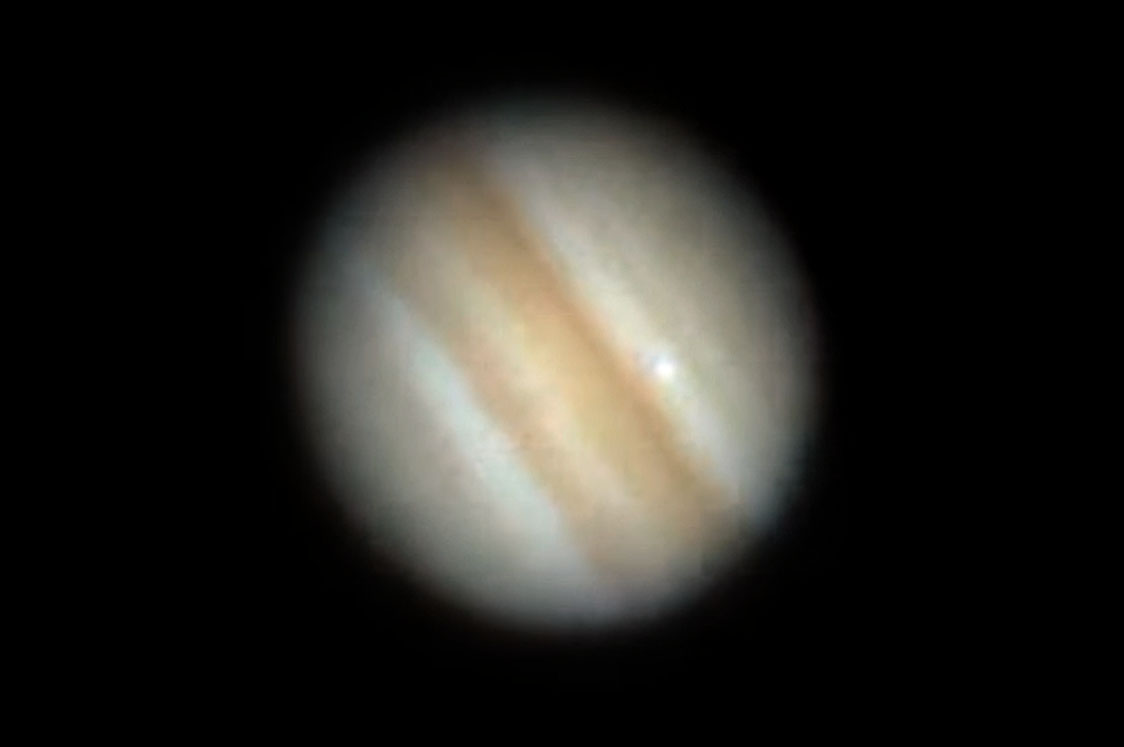
Jupiter Whacked Again? Japanese Astronomers Record Possible Impact
A group of Japanese astronomers has just discovered a potential new impact, recorded as a bright flash, at the planet Jupiter.
A group of Japanese astronomers just discovered a potential new impact at the planet Jupiter.
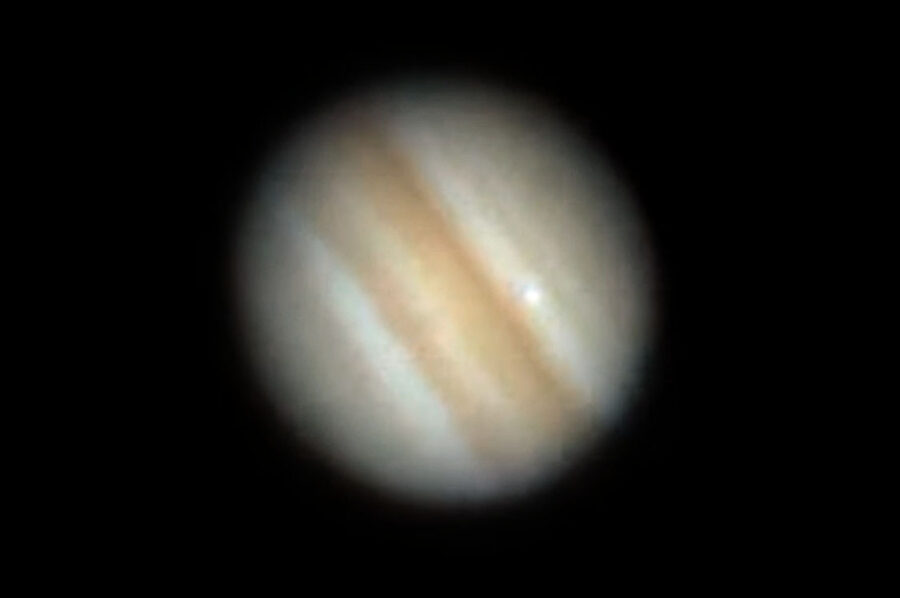
Jupiter impact flash Oct. 15, 2021 Japanese amateur astronomer yotsuyubi21 captured a possible impact flash in Jupiter's North Tropical Zone (NTrZ) at 13:24 UT on October 15th using a Celestron C6. See update note at the end of this post.
Get your scorecards out — Jupiter just took another interplanetary hit. If it's confirmed it would be the 11th observed comet or asteroid strike at the gas giant since the pieces of Comet Shoemaker-Levy 9 slammed into Jupiter in 1994.
A little more than a month after five amateurs independently recorded a similar flash, a team of astronomers, led by Ko Arimatsu of Kyoto University, captured this most recent flare in Jupiter's cloud tops (IR/visible image below) at 13:24 UT on Friday, October 15th.
Arimatsu and the group used a surveillance system called PONCOTS as part of the Organized Autotelescopes for Serendipitous Event Survey (OASES) project to make their discovery. The event occurred in Jupiter's North Tropical Zone near the southern edge of the North Temperate Belt at latitude +20° North and longitude 201° (System II). From the video, the burst lasted about 4 seconds. It quickly rises into visibility, maintains a steady light for about 2 seconds and then swiftly disappears.
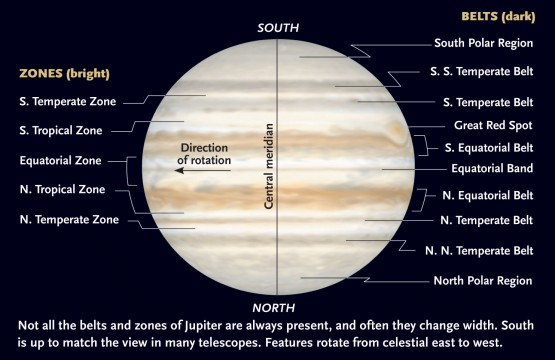
Jupiter displays alternating dark belts and bright zones that help in identifying any potential impact scars in the wake of the most recent flash. Zones are colder and mark upwelling ammonia ice clouds; belts are warmer regions marked by descending gases.
Sky & Telescope illustration
According to the Europlanet Society, on average 6½ objects 10 meters across and larger (that is, big enough for amateurs to record) hit Jupiter each year. Aided by transient-alert software like DeTeCt, we've seen a steady uptick in the number of impacts in recent years, proving that the more we look, the more we see. The most recent impact, in September, didn't produce a visible impact scar. This one may not either. But both events make us keenly aware of the potential hazards that still lurk in our solar system.
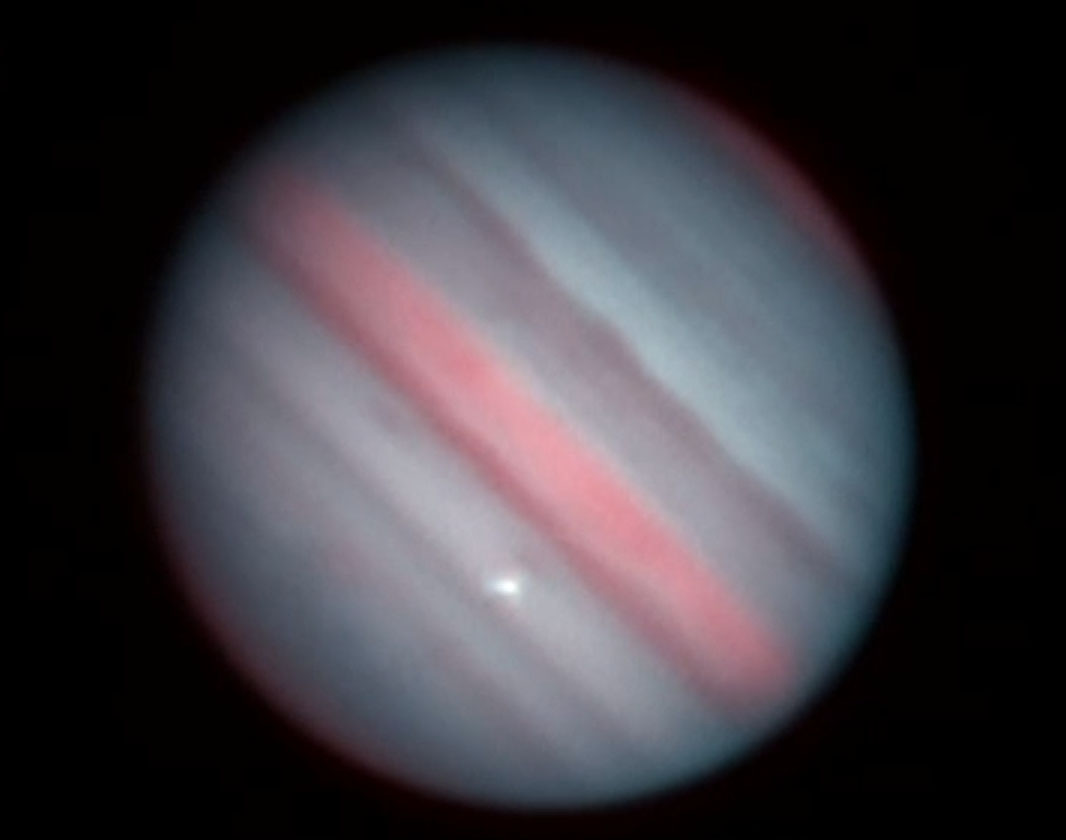
Jupiter impact flash in false color This is a false-color view of the impact, combining visible and infrared exposures. He used a 28-cm Schmidt-Cassegrain telescope (Celestron C11) and an original, Python-based pipeline developed for impact flash detections
Ko Arimatsu / Kyoto University
RT / 17:08
Upcoming bright comets according to José J. Chambó of Cometografia.
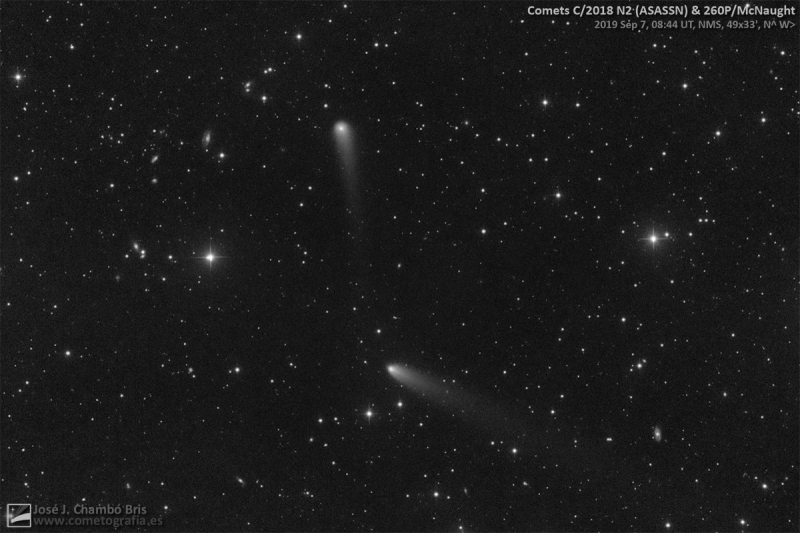
Próximos cometas brillantes - Cometografía
Estos son los cometas más brillantes en la actualidad y los que lo serán próximamente. Cuándo será su máximo y desde dónde serán observables.
NEOWISE: the next nine nights
NEOWISE: die nächsten neun Nächte
22. Jul Verfasst von skyweek
#SPMN231021 recorded today at 1h44m55s TU (3h44m local time). This video captured from Estepa, Seville by Antonio J. Robles
@AJ_Robles. This small rock from Comet 2P / Encke broke apart in the atmosphere without producing meteorites. Soon on the list

 solarsystem.nasa.gov
solarsystem.nasa.gov
#SPMN221021E recorded last night flying over the province of #Salamanca at 19h19m34s (21h19m local time). Video captured by Antonio J. Robles @AJ_Robles from Estepa, Seville. A faint aggregate of Comet 3D / Biela: Andromedida. Details:http://spmn.uji.es/ESP/SPMNlist.h LAST BOLIDOS REGISTERED BY THE SPMN NETWORK
A snip of a long comprehensive post.
The most luminous shooting stars, those that equal or exceed the planet Venus (brightness magnitude -4 or less) are called the bolid or fireball . These phenomena are produced when a rock of interplanetary origin penetrates the Earth's atmosphere at speeds between 11 and 73 km / s. They are usually rocks detached from asteroids, comets or, more rarely, from the Moon or Mars.
From the Research Network on Bolids and Meteorites we study these phenomena since they inform about the arrival of meteorites, valuable samples of innumerable bodies of the Solar System. Below you will find a list of the most luminous bolides registered over Spain this year, and at the end there is a link to lists of previous years (since they began to be systematically registered by our network in 1999). This list is intended to be exhaustive (except for errors or omissions) for all the bolides whose brightness magnitude has been less than -7 (this is 16 times greater than the luminosity of the planet Venus). -12 magnitude bolids would have the luminosity of the full Moon and would already be at the limit of generating meteorites that, normally, tend to be tens or hundreds of times more luminous.
The following annual list also gives a scientific explanation to the bolides, given that in the "origin" sectionit is indicated if its origin is associated with some meteoric swarm or if, on the contrary, it is "sporadic" (not associated with a swarm or that it has lost its orbital kinship with its parent body).
Constantly rocks whose size ranges from centimeters to a few meters in diameter reach the Earth from the main asteroid belt as a consequence of gravitational disturbances with the planets as you can read in thisConstantly rocks whose size ranges from centimeters to a few meters in diameter reach the Earth from the main asteroid belt as a consequence of gravitational disturbances with the planets as you can read in this Constantly rocks whose size ranges from centimeters to a few meters in diameter reach the Earth from the main asteroid belt as a consequence of gravitational disturbances with the planets as you can read in thisinformative article .
Maintaining this page is a huge challenge, but it allows a rational explanation to be given to these luminous phenomena. This work is maintained thanks to a joint effort given that currently our hundred detectors cover about 95% of the Iberian Peninsula from more than 30 automatic and digital detection stations that operate every day of the year. or. Given this wide coverage, we annually detect more than 500 bolids, although statistically it is estimated that annually less than a dozen could produce meteorites in the Iberian Peninsula (1 or 2 with a mass greater than one kilogram). The detailed study of the trajectories of these fireballs allows us to determine in those cases the possible places of meteorite fall, although their recovery is not always feasible due to the intrinsic difficulties of each place. On the other hand, by determining their heliocentric orbits we can deduce their origin in the Solar System. All these results are published inprestigious magazines where we collect the gratitude to the visual testimonies or photographs that they send us. It is everyone's job to ensure that these luminous phenomena are properly and scientifically interpreted to develop the pseudoscience of our country.
Snip:
"In the heavens above, it's raining dirt.
Every second, millions of pieces of dirt that are smaller than a grain of sand strike Earth's upper atmosphere. At about 100 kilometers altitude, bits of dust, mainly debris from asteroid collisions, zing through the sky vaporizing as they go 10 to 100 times the speed of a bullet. The bigger ones can make streaks in the sky, meteors that take our breath away.
Scientists are using supercomputers to help understand how tiny meteors, invisible to the naked eye, liberate electrons that can be detected by radar and can characterize the speed, direction and rate of meteor deceleration with high precision, allowing its origin to be determined. Because this falling space dust helps seed rain-making clouds, this basic research on meteors will help scientists more fully understand the chemistry of Earth's atmosphere. What's more, meteor composition helps astronomers characterize the space environment of our solar system".

Canada
Event AMS #6843-2021
Oct 23, 2021
Oct 23, 2021
NEOWISE: die nächsten neun Nächte
22. Jul Verfasst von skyweek
#SPMN231021 recorded today at 1h44m55s TU (3h44m local time). This video captured from Estepa, Seville by Antonio J. Robles
@AJ_Robles. This small rock from Comet 2P / Encke broke apart in the atmosphere without producing meteorites. Soon on the list

2P/Encke - NASA Science
Comet 2P/Encke was first discovered by Pierre F. A. Mechain on Jan. 17, 1786. Other astronomers located this comet in subsequent passages, but these sightings
#SPMN221021E recorded last night flying over the province of #Salamanca at 19h19m34s (21h19m local time). Video captured by Antonio J. Robles @AJ_Robles from Estepa, Seville. A faint aggregate of Comet 3D / Biela: Andromedida. Details:http://spmn.uji.es/ESP/SPMNlist.h LAST BOLIDOS REGISTERED BY THE SPMN NETWORK
A snip of a long comprehensive post.
The most luminous shooting stars, those that equal or exceed the planet Venus (brightness magnitude -4 or less) are called the bolid or fireball . These phenomena are produced when a rock of interplanetary origin penetrates the Earth's atmosphere at speeds between 11 and 73 km / s. They are usually rocks detached from asteroids, comets or, more rarely, from the Moon or Mars.
From the Research Network on Bolids and Meteorites we study these phenomena since they inform about the arrival of meteorites, valuable samples of innumerable bodies of the Solar System. Below you will find a list of the most luminous bolides registered over Spain this year, and at the end there is a link to lists of previous years (since they began to be systematically registered by our network in 1999). This list is intended to be exhaustive (except for errors or omissions) for all the bolides whose brightness magnitude has been less than -7 (this is 16 times greater than the luminosity of the planet Venus). -12 magnitude bolids would have the luminosity of the full Moon and would already be at the limit of generating meteorites that, normally, tend to be tens or hundreds of times more luminous.
The following annual list also gives a scientific explanation to the bolides, given that in the "origin" sectionit is indicated if its origin is associated with some meteoric swarm or if, on the contrary, it is "sporadic" (not associated with a swarm or that it has lost its orbital kinship with its parent body).
Constantly rocks whose size ranges from centimeters to a few meters in diameter reach the Earth from the main asteroid belt as a consequence of gravitational disturbances with the planets as you can read in thisConstantly rocks whose size ranges from centimeters to a few meters in diameter reach the Earth from the main asteroid belt as a consequence of gravitational disturbances with the planets as you can read in this Constantly rocks whose size ranges from centimeters to a few meters in diameter reach the Earth from the main asteroid belt as a consequence of gravitational disturbances with the planets as you can read in thisinformative article .
Maintaining this page is a huge challenge, but it allows a rational explanation to be given to these luminous phenomena. This work is maintained thanks to a joint effort given that currently our hundred detectors cover about 95% of the Iberian Peninsula from more than 30 automatic and digital detection stations that operate every day of the year. or. Given this wide coverage, we annually detect more than 500 bolids, although statistically it is estimated that annually less than a dozen could produce meteorites in the Iberian Peninsula (1 or 2 with a mass greater than one kilogram). The detailed study of the trajectories of these fireballs allows us to determine in those cases the possible places of meteorite fall, although their recovery is not always feasible due to the intrinsic difficulties of each place. On the other hand, by determining their heliocentric orbits we can deduce their origin in the Solar System. All these results are published inprestigious magazines where we collect the gratitude to the visual testimonies or photographs that they send us. It is everyone's job to ensure that these luminous phenomena are properly and scientifically interpreted to develop the pseudoscience of our country.
Snip:
"In the heavens above, it's raining dirt.
Every second, millions of pieces of dirt that are smaller than a grain of sand strike Earth's upper atmosphere. At about 100 kilometers altitude, bits of dust, mainly debris from asteroid collisions, zing through the sky vaporizing as they go 10 to 100 times the speed of a bullet. The bigger ones can make streaks in the sky, meteors that take our breath away.
Scientists are using supercomputers to help understand how tiny meteors, invisible to the naked eye, liberate electrons that can be detected by radar and can characterize the speed, direction and rate of meteor deceleration with high precision, allowing its origin to be determined. Because this falling space dust helps seed rain-making clouds, this basic research on meteors will help scientists more fully understand the chemistry of Earth's atmosphere. What's more, meteor composition helps astronomers characterize the space environment of our solar system".
Canada
Event AMS #6843-2021
https://youtu.be/tey8cCaGyjgOct 23, 2021
October zeta Perseids: astronomers have discovered a meteor swarm
The search for the parent body of these meteors according to orbital elements has not yielded results so far. The new meteor swarm is officially listed in the International Astronomical Union's meteor swarm worksheet
Croatian astronomers have discovered a new meteor swarm - the October zeta Perseids, the Croatian Astronomical Union announced on Friday.
Namely, the Central Bureau of Astronomical Telegrams (CBAT) of the International Astronomical Union (IAU) reported on October 28 that dr. Denis Vida of the University of Western Ontario and Damir Segon of the Croatian Meteor Network (HMM) "reported a radiant meteor burst in Perseus, or 14 meteors recorded by Global Meteor Network (GMN) cameras on the night of October 24 this year," according to press release.
Half of the meteors were observed in the first 30 minutes of activity, and the activity lasted a total of 3 hours.
The search for the parent body of these meteors according to orbital elements has not yielded results so far. The new meteor swarm is officially listed in the International Astronomical Union (IAU) Meteor Swarm Working List under number 1131 and is named the October zeta Perseids (OZP).
A new meteor swarm filmed from Croatia as well
The Global Meteor Network is a project that grew out of the Croatian Meteor Network and today has more than 300 cameras globally in more than 30 countries around the world.Five of the fourteen meteors were recorded by the cameras of the Croatian Meteorological Network in Hum (Istria), Zadar, Virovitica, Đakovo, Ogulin, Požega and on Mosor (Split), Čiovo, Korčula and Hvar on the Humac hill above Jelsa.
From Croatian Astronomical Union:
CROATIAN ASTRONOMISTS DISCOVER NEW METEOR SWARM - OCTOBER ZETA PERZEIDE
According to the Central Bureau of Astronomical Telegrams (CBAT) of the International Astronomical Union (IAU), on October 28, Dr. Denis Vida from the University of Western Ontario and Damir Šegon from the Croatian Meteor Network (HMM) reported a meteor burst in Perseus and 14 meteors, respectively. recorded by Global Meteor Network (GMN) cameras on the night of October 24 this year. Half of the meteors were observed in 30 minutes of peak activity, and the activity lasted a total of 3 hours. The search for the parent body of these meteors according to orbital elements has not yielded results so far. The new meteor swarm is officially listed in the International Astronomical Union (IAU) Meteor Swarm Working List under number 1131 and is named the October zeta Perseids (OZP).
A NEW METEOR SWARM WAS ALSO RECORDED FROM CROATIA
The Global Meteor Network is a project that grew out of the Croatian Meteor Network and today has more than 300 cameras globally in over 30 countries. Five of the fourteen meteors were recorded by the cameras of the Croatian Meteorological Network in Hum (Istria), Zadar, Virovitica, Đakovo, Ogulin, Požega and on Mosor (Split), Čiovo, Korčula and Hvar on the hill Humac (#jelsa #visitjelsa). In recent years, the Croatian Meteor Network project has been partly financed and maintained through the Croatian Astronomical Association, ie Public Needs in Technical Culture of the Republic of Croatia (Croatian Association of Technical Culture and the Ministry of Science and Education).
More information at:
https://www.meteornews.net/…/october-zeta-perseid-meteor-s…/
In recent years, the Croatian Meteor Network project has been partly financed and maintained through the Croatian Astronomical Association, ie Public Needs in Technical Culture of the Republic of Croatia (Croatian Association of Technical Culture and the Ministry of Science and Education), said Dorian Božičević.
More information can be obtained at https://www.meteornews.net/.../october-zeta-perseid.../
A newly-discovered asteroid made a close approach to Earth on November 1, 2021.
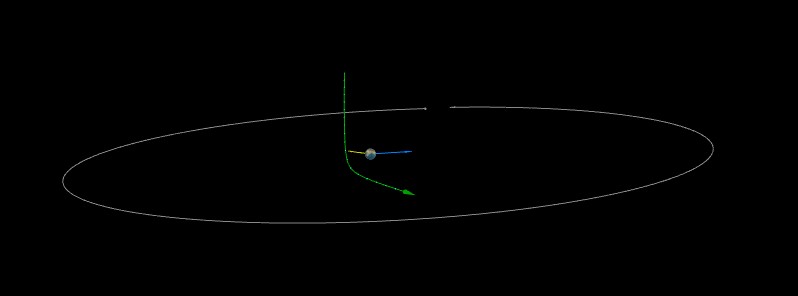
 watchers.news
Posted by Teo Blašković on November 3, 2021
watchers.news
Posted by Teo Blašković on November 3, 2021

 theskylive.com
theskylive.com
A bright fireball streaked through the night sky over the Parana and Rio Grande do Sul, Brazil.
Published on Nov 3, 2021 (1:20)
More here.

Asteroid 2021 VH flew past Earth at just 0.08 LD
A newly-discovered asteroid designated 2021 VH flew past Earth at 0.08 LD / 0.00020 AU (29 919 km / 18 591 miles) from the center of our planet at 10:33 UTC on November 1, 2021. This is about 23 500…

Asteroid (NEO) 2021 VH | TheSkyLive.com
Discover all the most important facts and information about Asteroid (NEO) 2021 VH updated in real time
A bright fireball streaked through the night sky over the Parana and Rio Grande do Sul, Brazil.
Published on Nov 3, 2021 (1:20)
More here.
That one was pretty close. Notice this:
Asteroid 2021 VH was first observed at ATLAS-MLO, Mauna Loa, Hawaii on November 2, one day after it made its close approach.
That one was pretty close. Notice this:
Yes and it pretty much looks like the alltime record from last year of such objects has already been surpassed this year, making this year the next record breaker. I haven’t calculated it through yet, but glimpsing over the data it looks like we have already surpassed last years record:
Out of curiosity I just looked up how many objects came closer to earth than the moon in 2021. Already 54 such objects slipped by this year! And we still have more than 7,5 months to go until the end of this year. In the whole of last year 107 such objects slipped by earth. If that trend continues (see below) it very much looks like the all-time record number of last year (107 objects) could be overtrumped again quite significantly this year:
128 days (in 2021) ≙ 54 Objects recorded
365 days ≙ approx. 154 Objects (theoretical extrapolation for the whole year of 2021)
Compared to 107 such objects recorded in 2020.
Stay tuned for the next data installment for this year, early next year. Looks like it will be another record year in several departments!
@IyC_es that describes our study published in #MNRAS@RAS_JournalsI invite you to read it: https://investigacionyciencia.es/blogs/astronomia/45/posts/aprendiendo-de-los-cometas-a-partir-del-estudio-de-los-enjambres-metericos-20450@CSI @iSpaceSci@IEEC_space@CSICCat@AsteroidDayESP
Full Video
That one was pretty close. Notice this: Asteroid 2021 VH was first observed at ATLAS-MLO, Mauna Loa, Hawaii on November 2, one day after it made its close approach.
Visible Comets in November
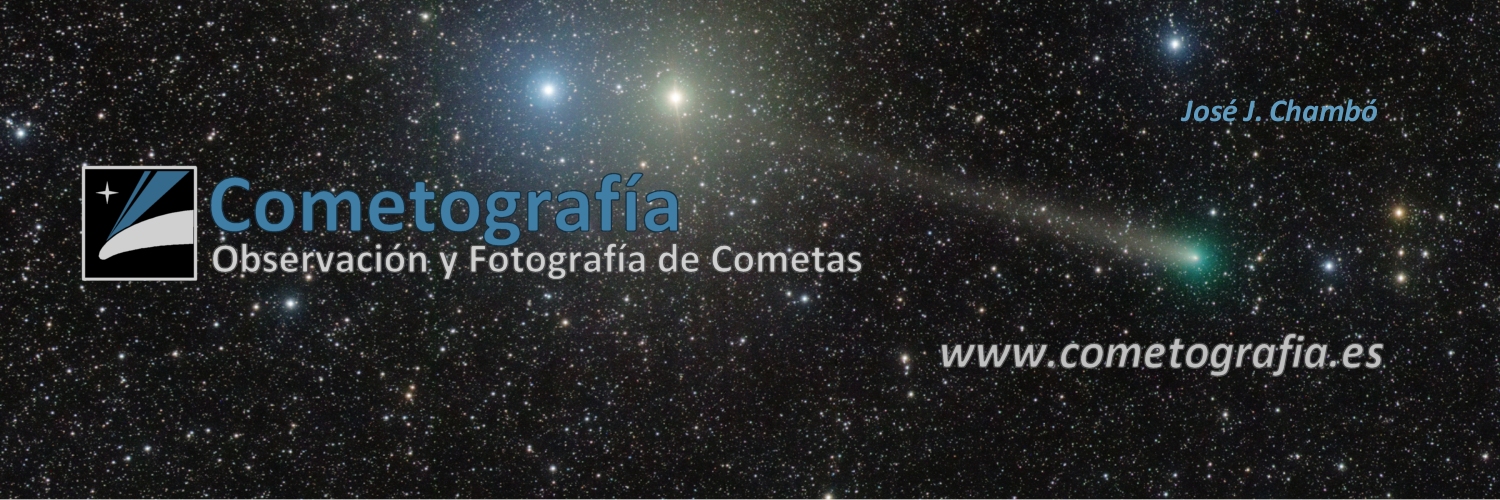
Cometografía - Observación y fotografía de cometas
Observación y fotografía de cometas
There was a video about a European Meteor Network based in Germany. Their website has an archive of past fireball events recorded from the perspective of different cameras. Some events have so many that one needs to use the left-right side scroll bar to see them all. The clearer recordings are nearest to the left.Oct 15, 2021
The recordings show different altitudes and angle in the sky for the same event. It is what one would expect, but it is interesting to see it demonstrated in such a clear fashion.
It appears the following meteor has a small faint companion for a short period. This could mean that it had fragmented at some point or had a real companion. One can see it in different videos, though not equally clearly.
Regarding the recent observation, the archive has uploaded:
This fireball is high and bright in the sky in the video to the left and very low over the horizon in the video from Antwerp in Belgium. It is so low that one probably would not usually see many stars there, if the sky had the usual haze and is light polluted by even distant town light. What this means is that if one observes a bright meteor low in the sky, close to the horizon, it is much more spectacular for those who are nearer.
Trending content
-
-
Thread 'Coronavirus Pandemic: Apocalypse Now! Or exaggerated scare story?'
- wanderingthomas
Replies: 30K -
Thread 'Mass Shooting at Bondi Beach, Sydney, targets Jews celebrating Hanukkah'
- Rhythmik
Replies: 134
